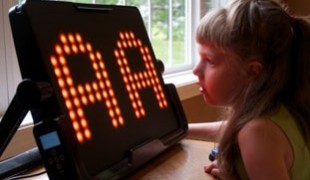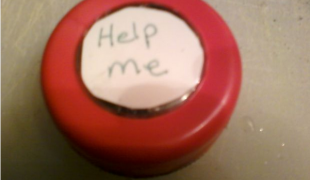- 6238
- 441
- 12
- 11
- 0
- Help Ukraine
About the solution
David Hayden, a freshman double-majoring in math and computer science at Arizona State University, is visually impaired because of a condition that prevents optic nerves to fully develop, the bilateral optic nerve hypoplasia. This condition prevents to see and focus details which are a few feet away. Students with this condition often use a monocular to see the board but they do not always follow the class easily.
The Centre for Cognitive Ubiquitous Computing (CUbiC) at Arizona State University, focused on serving the needs of physically challenged individuals, gave David the opportunity to work on assistive technologies. In 2007, David partnered with John Black, a research scientist at CUbiC, to develop a solution for his struggles.
The prototype they developed consists of an application on a tablet connected to a camera with a pan-tilt-zoom feature. The device was portable and allowed David to have the video of the blackboard in his laptop. To improve his experience, David split the screen in two, having on one side the video of the blackboard and on the other side a space to design and take notes with pen input. David also linked section of the notes to the video.
The developed prototype was improved after receiving feedback from other visually impaired students. In 2010, the invention won the Microsoft Imagine Cup competition in the ‘touch and tablet’ category. "External competitions are always great motivators to help you think more critically about a project. Not only do you need to sell it to yourself, you have to sell it to others! The Imagine Cup was a great venue for both reasons. I think we underestimated the publicity that would come from it," Hayden says.
In 2011, the team focused on the design, developing not only a functional but also a cute device. Eventually, the team won second place in the Software Design Category of the Microsoft Imagine Cup competition.
After graduating, David received an internship opportunity at NASA, and he pursued a PhD at MIT. David started manufacturing his Note-Taker in 2015, after founding his company HaydenAt.
Adapted from: https://slate.com/technology/2015/03/the-best-adaptive-technologies-are-...
https://www.wired.com/2012/06/imagine-cup-alumni-spotlight-note-taker/
More information: https://www.youtube.com/watch?v=Sf1Kwoq-844&feature=emb_title
This solution shall not include mention to the use of drugs, chemicals or biologicals (including food); invasive devices; offensive, commercial or inherently dangerous content. This solution was not medically validated. Proceed with caution! If you have any doubts, please consult with a health professional.
DISCLAIMER: This story was written by someone who is not the author of the solution, therefore please be advised that, although it was written with the utmost respect for the innovation and the innovator, there can be some incorrect statements. If you find any errors please contact the patient Innovation team via info@patient-innovation.com
-
-
566
-
0
-
8442

Mother invents device to help hearing and visually impaired daughter
COMMUNICATION: Communicating, whether by speaking, listening, or other means
Reading
Studying
Blindness
Educational/Leisure device (book, toy, game...)
App (Including when connected with wearable)
Vision problems
Regaining sensory function
Promoting self-management
Improving Speech and Communication
Caregiving Support
Ophthalmology
United States
-
-
-
583
-
0
-
8463

Music to help autistic children
COMMUNICATION: Communicating, whether by speaking, listening, or other means
CAREGIVING
Listening to music
Autism
Podcast
Educational/Leisure device (book, toy, game...)
Social Media
Difficulties with speech
Difficulties learning how to talk
Promoting self-management
Managing Neurological Disorders
Promoting inclusivity and social integration
Improving Speech and Communication
To improve Treatment/Therapy
Raise awareness
Caregiving Support
Child and Adolescent Psychiatry
Neurology
Pediatrics
Psychiatry
United States
-
-
-
533
-
0
-
7865

Father adapts My Button E Mac for his son
COMMUNICATION: Communicating, whether by speaking, listening, or other means
Social interaction
Assistive Daily Life Device (to help ADL)
Educational/Leisure device (book, toy, game...)
Treatment/Surgical device
Cognitive impairment
Difficulty speaking or understanding speech
Difficulties with speech
Improving Speech and Communication
To improve Treatment/Therapy
Caregiving Support
Neurology
Pediatrics
Psychiatry
Pediatric Innovations
Solutions for Disabled people
United States
-
 en
en